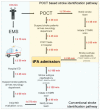Point-of-Care-Testing in Acute Stroke Management: An Unmet Need Ripe for Technological Harvest
- PMID: 28771209
- PMCID: PMC5618036
- DOI: 10.3390/bios7030030
Point-of-Care-Testing in Acute Stroke Management: An Unmet Need Ripe for Technological Harvest
Abstract
Stroke, the second highest leading cause of death, is caused by an abrupt interruption of blood to the brain. Supply of blood needs to be promptly restored to salvage brain tissues from irreversible neuronal death. Existing assessment of stroke patients is based largely on detailed clinical evaluation that is complemented by neuroimaging methods. However, emerging data point to the potential use of blood-derived biomarkers in aiding clinical decision-making especially in the diagnosis of ischemic stroke, triaging patients for acute reperfusion therapies, and in informing stroke mechanisms and prognosis. The demand for newer techniques to deliver individualized information on-site for incorporation into a time-sensitive work-flow has become greater. In this review, we examine the roles of a portable and easy to use point-of-care-test (POCT) in shortening the time-to-treatment, classifying stroke subtypes and improving patient's outcome. We first examine the conventional stroke management workflow, then highlight situations where a bedside biomarker assessment might aid clinical decision-making. A novel stroke POCT approach is presented, which combines the use of quantitative and multiplex POCT platforms for the detection of specific stroke biomarkers, as well as data-mining tools to drive analytical processes. Further work is needed in the development of POCTs to fulfill an unmet need in acute stroke management.
Keywords: Biomarkers; Data-Mining; Diagnostics; Multiplex and Quantitative Detection; Point-of-Care-Test; Stroke; Time-Dependent Treatment.
Conflict of interest statement
The authors declare no conflict of interest
Figures




Similar articles
-
A novel electronic algorithm using host biomarker point-of-care tests for the management of febrile illnesses in Tanzanian children (e-POCT): A randomized, controlled non-inferiority trial.PLoS Med. 2017 Oct 23;14(10):e1002411. doi: 10.1371/journal.pmed.1002411. eCollection 2017 Oct. PLoS Med. 2017. PMID: 29059253 Free PMC article. Clinical Trial.
-
Current and Emerging Trends in Point-of-Care Technology and Strategies for Clinical Validation and Implementation.Clin Chem. 2018 Oct;64(10):1439-1452. doi: 10.1373/clinchem.2018.287052. Epub 2018 Jun 8. Clin Chem. 2018. PMID: 29884677 Review.
-
Timely and Blood-Based Multiplex Molecular Profiling of Acute Stroke.Life (Basel). 2021 Aug 11;11(8):816. doi: 10.3390/life11080816. Life (Basel). 2021. PMID: 34440560 Free PMC article. Review.
-
[Standard technical specifications for methacholine chloride (Methacholine) bronchial challenge test (2023)].Zhonghua Jie He He Hu Xi Za Zhi. 2024 Feb 12;47(2):101-119. doi: 10.3760/cma.j.cn112147-20231019-00247. Zhonghua Jie He He Hu Xi Za Zhi. 2024. PMID: 38309959 Chinese.
-
Trial design and reporting standards for intra-arterial cerebral thrombolysis for acute ischemic stroke.Stroke. 2003 Aug;34(8):e109-37. doi: 10.1161/01.STR.0000082721.62796.09. Epub 2003 Jul 17. Stroke. 2003. PMID: 12869717
Cited by
-
APIS: a paired CT-MRI dataset for ischemic stroke segmentation - methods and challenges.Sci Rep. 2024 Sep 4;14(1):20543. doi: 10.1038/s41598-024-71273-x. Sci Rep. 2024. PMID: 39232010 Free PMC article.
-
Utility of Exosomes in Ischemic and Hemorrhagic Stroke Diagnosis and Treatment.Int J Mol Sci. 2022 Jul 28;23(15):8367. doi: 10.3390/ijms23158367. Int J Mol Sci. 2022. PMID: 35955498 Free PMC article. Review.
-
Simple Electric Device to Isolate Nucleic Acids from Whole Blood Optimized for Point of Care Testing of Brain Damage.Curr Neurovasc Res. 2022;19(3):333-343. doi: 10.2174/1567202619666220903105805. Curr Neurovasc Res. 2022. PMID: 36056832 Free PMC article.
-
Point-of-Care Surface Plasmon Resonance Biosensor for Stroke Biomarkers NT-proBNP and S100β Using a Functionalized Gold Chip with Specific Antibody.Sensors (Basel). 2019 Jun 3;19(11):2533. doi: 10.3390/s19112533. Sensors (Basel). 2019. PMID: 31163612 Free PMC article.
-
Metal-Oxide FET Biosensor for Point-of-Care Testing: Overview and Perspective.Molecules. 2022 Nov 17;27(22):7952. doi: 10.3390/molecules27227952. Molecules. 2022. PMID: 36432052 Free PMC article. Review.
References
-
- Bhavna J. Stroke Diagnostics and Therapeutics: Global Markets. BCC research; Wellesley, MA, USA: 2015.
-
- Goldstein L.B., Adams R., Alberts M.J., Appel L.J., Brass L.M., Bushnell C.D., Culebras A., Degraba T.J., Gorelick P.B., Guyton J.R., et al. Primary prevention of ischemic stroke: A guideline from the american heart association/american stroke association stroke council: Cosponsored by the atherosclerotic peripheral vascular disease interdisciplinary working group; cardiovascular nursing council; clinical cardiology council; nutrition, physical activity, and metabolism council; and the quality of care and outcomes research interdisciplinary working group: The American academy of neurology affirms the value of this guideline. Stroke. 2006;37:1583–1633. - PubMed
-
- Allender S., Scarborough P., Peto V., Rayner M., Leal J., Luengo-Fernandez R., Gray A. European Cardiovascular Disease Statistics. European Heart Network; Brussels, UK: 2008.
-
- Charles P.W., Jan V.G., Martin S.D., Joanna M.W., John M.B., Graeme J.H., Peter A.G.S., Gabriel R., Peter L., Cathie S., et al. Stroke: Practical Management. 3rd ed. Wiley-Blackwell; Tokyo, Japan: 2008.
Publication types
MeSH terms
Substances
LinkOut - more resources
Full Text Sources
Other Literature Sources
Medical

